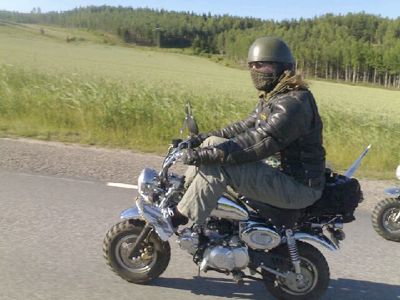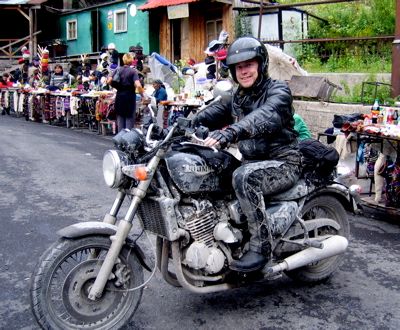Land of the Basuthu

The evening around the fire was amazing. The fire circle is located on a good vantage point on the hill, with view opening across the small nature preservation area to the west and Pretorian suburb to the south.
Full moon was shining, there was distant thunder illuminating clouds over the hills, and the area was filled by sounds of frogs and night birds. Rudi made us some traditional South African stew on the fire in a big round potjie kettle, which we enjoyed with some excellent local stout beers and red wine.
After dinner we fetched some African drums and enjoyed the combination of drumming, cuban cigar and some songs from different places. I sang "Murheellisten laulujen maa" and Andrea some tango from Buenos Aires.
In the next morning we had the final discussions related to the Midgard training and started packing for the trip. As in South Africa normal stores can't sell alcohol we had to take a quick visit to a liquor store to get the required camping bottles.
With all the hassle involved in preparations we were able to leave only around four, after having to return to the house to leave right doors open for Justice the gardener.
We took a quick stop in Johannesburg to get a road map of Lesotho and joined the friday evening traffic heading south on N3. We reached the Midlands in dark, heading for a backpackers' inn on the foot of the Drakensberg mountains. The gravel road in the hilly terrain was very twisty and we passed lots of Tolkienesque place names, including Hobbit's Hut and Rivendell.
It was midnight when we reached the inn, and staff was sleeping. They had left a note for us to help ourselves, and after some discussion we decided to skip the dorm room and set up tents on the front yard.
In morning we drove to the nearby town of Underberg for some supplies. We found a nice small camping store where I was able to get a leather safari hat to keep the correct appearances. After the California-like Pretoria Underberg had a really African feel to it, streets filled with people, market stalls and minibuses.
On the way to Sani Pass we stopped in The Himeville Arms pub for some local Pale Ale, but the place was unfortunately out of it. After a quick tanking stop we started the ascent up the pass.
Sani Pass is the most famous mountain road in southern Africa, and driving it is only allowed for real 4x4 vehicles. The scenery was quite breathtaking, with the jagged edge of the Dragensberg escarpment above and rolling hills below, with an occasional stream or waterfall. The South African border check point was located in the first part of the pass. The border officials had some issues with Toni's working permit but otherwise we were able to get through easily.
On the top of the pass we got to the mountain plateau opening above the escarpment, with the Lesotho border post, some native round houses built of loose stones, and finally Sani Top Chalet, the highest pub in Africa (29°35'08 S, 29°17'14 E. Tel +27-33-702-1158, web www.sanitopchalet.co.za).
The Chalet is an inn built in the beginning of the sixties for adventurers entering Lesotho through the Sani Pass. The place had the feeling of a classical ski lodge, with all the old photos, skiing equipment on the walls and comfortable sofas arranged around fireplaces.
Toni went walking on the Drakensberg ridge to get some photos while we sat down for some of the Pale Ales we had previously missed in Himeville. While Toni was out a quite sudden hailstorm came from behind the mountains. Anticipating his wet and cold return we ordered him an Irish Coffee and tried to make the fire in the fireplace bigger. He came back smiling to our big surprise but still seemed glad to get the warm drink.
Because of the weather change most of us decided to stay in the Chalet's dorm room while Rudi and Ryan set up their tent to front of the inn. In the dorm we met Bo, a Dane who had left his job in an IT consulting company in Denmark two years earlier to come eRiding in the rural Lesotho. Our group was quite surprised to meet a fellow eRider, and the rest of the evening went comfortably around a nice dinner swapping stories about working with NGOs or life in Lesotho. During the course of the night we managed to drink the Chalet out of the Pale Ale and switched to Maluti, a local beer brand.
In the morning we started sorting our gear for the hike ahead, and discussing potential routes with the innkeeper. We didn't have any maps of the area, and the only ones the Chalet could provide were large wall-sized ones. The innkeeper drew us a "treasure map" of few lines about the route to mount Thabana-Ntlenyana, the highest peak in southern africa. the lack of a real map was not a problem as we had a GPS navigator and were able to estimate the coordinates of the peak from one of the maps. As a precaution, Toni also took some digital photos of the map. I bought a nice dark wooden walking stick for the climbs.
Everything sorted out, we left the inn around 11am. We decided to climb the first mountain on our way for the scenery value instead of walking around it as the innkeeper had advised. The ascent proved to be much more difficult than assumed. While the others had been more acclimatized in Pretoria, I had really some issues with getting enough breath on the high altitudes. However, the sight from the top was certainly worth it, with endless hills and mountains opening to all directions.
Above the first mountain it became clear that regardless of their bare look, the mountains were filled with life. Huts of the rural Basuthu people were scattered all around the valleys, and the mountain sides were full of sheep and horses grazing under the watchful eyes of shepherd boys.
We met the first Basuthu shepherds on top of the mountain. The shepherds were all dressed in the traditional dress of a loincloth, woolen balaclava hats, gum boots and a blanket worn on the shoulders in fashion reminding of Scottish kilts or Viking cloaks. Apparently with this gear the shepherds would be able to survive in the harsh mountain weather all year round.
The shepherds were very curious of us and our hiking gear, and were happy to give us instructions and pose for photos, even though we didn't have a common language. Some of the shepherd boys knew English phrases, mostly limited to the greeting "good morning". We tried to learn some Suthu language from them but lacking common vocabulary it proved to be too time consuming, limiting our communications pretty much to sign language, place names and the local OK, "sharp".
After the first mountain we descended to a nice river valley where we had a short break for light lunch and filtering more drinking water. There were many horses grazing nearby, and some donkeys came to drink from the stream very near us.
We continued our way on top of the next mountain, and saw that there would be yet another valley before we would actually get to climb the sides of Thabana-Ntlenyana. As sun was getting nearer to horizon we decided to camp near the river on the bottom. It took a while to find a reasonably dry position. When we were preparing to set up tents three shepherd boys came talking to us, and explained that we couldn't camp there, as there were diamonds in the river. After offering to dig us some for ten rands, which we declined, the boys agreed to show us a place where we could sleep. The place was a nice small hill (29°29'59 S, 29°16'26 E) between two streams with a magnificent view to the nearby mountains and valleys.
While we were setting up tents more shepherds came to watch us. While communication was difficult we were able to share some laughs and information. They seemed especially amused about my walking stick, and tried to swap it for one of their shepherd sticks. Most of the shepherds left when we started making food, but one younger boy stayed, starting to ask us for stuff, like "give me your watch". Obviously we didn't give him anything, and his attitude made us a bit wary as we were in a very remote place, surrounded by only some Basuthu settlements.
Bo had told us a story on the previous night about some Peace Corps volunteers who had been set up by their guide and mugged in the mountains. We made some precautions like stuffing all valuables to bags that could be easily picked up should we need to flee the spot. We mostly discounted this as paranoia, however, and continued spending the evening around some rum and sherry as the night kept colder. The weather was very clear and it was easy to see a huge number of stars, and the shape of Milky Way and two other galaxies. When we finally crawled into our tents we noticed that some frost had accumulated on our bags. We fell asleep listening to singing from the Basuthu hut on the hill above us.
We woke up quite early in the morning. While we were breaking the camp one of the older Basuthu shepherds came down to us, playing an improvised violin built out of steel wire, some branches, horse hair and an oil can. He seemed to take artistic pride in both his self-made instrument and ability to play for an international audience.
After the concert we started ascending the mountain side. After a two hour climb, we reached the highest peak south of Kilimanjaro, Thabana-Ntlenyana, 3482m (29°28'10 S, 29°16'15 E). We took a long rest on the top, taking some pictures and sun bathing. I smoke some pipe and Ryan prepared us a bowl of vegetable curry. Five Basuthu shepherds came up to talk with us, and we prepared some cheese sandwiches for them. When we started our descent from the mountain two of them asked us not to go to the nearby valley, as their sheep were grazing there.
Bypassing the valley we walked to the edge of the Drakensberg, to a beautiful spot (29°29'39 S, 29°17'63 E) on top of a river valley opening the view towards Durban and Indian ocean. We could easily see Underberg and Himeville as small settled areas far below. We decided to try some geocaching, hiding some German Euro coins under a rock pile and taking down the coordinates. The coordinates would later be published on the internet so that somebody else could find the same stunning place. Geocacher would then try to find our Euro cache, take the coins and replace them with something else of equal value, enabling others to also seek the place. Apparently there are hundreds of similar caches around the world, all with stunning places out of typical hiking paths.
On the way back I was feeling quite exhausted and could almost feel the presence of beer back at the Sani Top lodge. When we finally arrived there the first sip of Pale Ale tasted unspeakably good, after going up and down mountains in the dry and hot Lesotho highlands. We had some more beers and a nice dinner of chicken curry. After the dinner we set up our tents and sat for a while in the dorm with some Tasmanians discussing abseiling and sharing a bottle of Salmari, a typical Finnish liquor.

